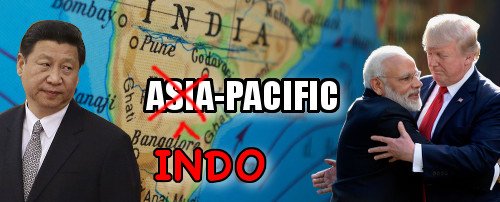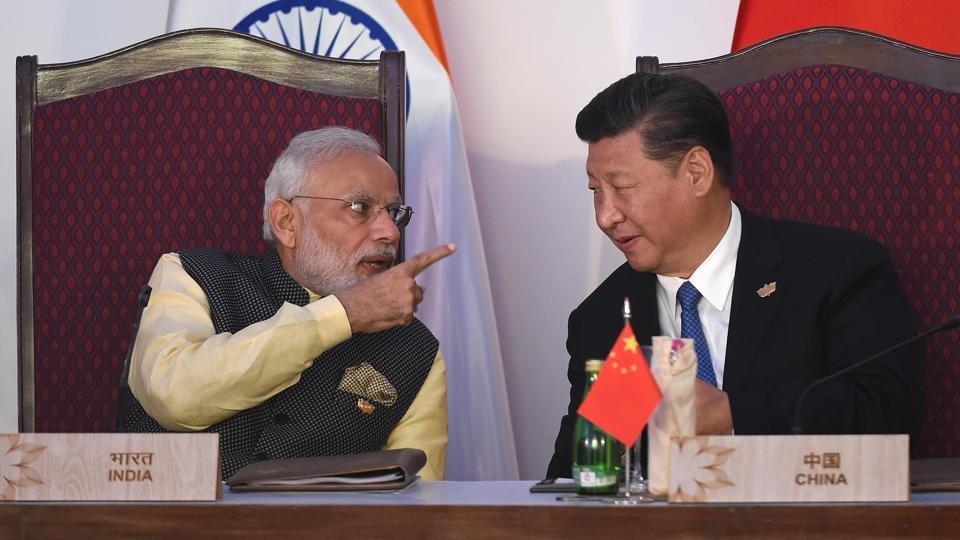by James Corbett
corbettreport.com
March 10, 2018
Goodbye, Asia-Pacific! Hello, Indo-Pacific?
That's right, the old "Asia-Pacific" label is so last decade, guys. It's time to start calling that part of the globe the "Indo-Pacific." Who cares if it's geographically nonsensical? America's military planners and their think tank lackeys are starting to change their nomenclature, and you should too!
The term entered the vernacular last year when Secretary of State Rex Tillerson used it in his "Remarks on 'Defining Our Relationship With India for the Next Century.'" It was immediately parroted by all the usual propaganda outlets, including the mouthpiece of the globalist establishment, CFR.org.
So why bother? What was wrong with "Asia-Pacific" as a descriptor and why now the shift to "Indo-Pacific?" When questioned about the change in terminology during Trump's Asia tour last year, a White House official told India's Economic Times that the phrase "captures the importance of India's rise."
There may be some truth to the narrative of India as a rising power. It has, after all, surpassed China as the fastest growing economy in the world and foreign investment figures indicate that boom might not be stopping any time soon.
But if you get the sense that Washington's sudden inclination to rename an entire region to reflect this rising importance is not merely about goodwill for the Indian people, then give yourself a prize. It has everything to do with Washington's interest in India's potential use as a pliable vassal state that can be used as a roadblock against the rise of the region's other great power: China.
But don't take that from me. Take it from Tillerson:
"[...]the very international order that has benefited India’s rise – and that of many others – is increasingly under strain.
"China, while rising alongside India, has done so less responsibly, at times undermining the international, rules-based order even as countries like India operate within a framework that protects other nations’ sovereignty.
"China’s provocative actions in the South China Sea directly challenge the international law and norms that the United States and India both stand for.
"The United States seeks constructive relations with China, but we will not shrink from China’s challenges to the rules-based order and where China subverts the sovereignty of neighboring countries and disadvantages the U.S. and our friends.
"In this period of uncertainty and somewhat angst, India needs a reliable partner on the world stage. I want to make clear: with our shared values and vision for global stability, peace, and prosperity, the United States is that partner."
As I reported in these very pages last year, relations between Beijing and New Delhi cooled when India declined to attend China's much ballyhooed first Belt and Road Forum for International Cooperation. The forum, held in Beijing last May, brought together 29 foreign heads of state to discuss China's proposed trillion dollar "One Belt One Road" project (OBOR) aimed at developing trade routes, infrastructure and development projects throughout the region. Given the incredible amounts of money China has been dispensing in recent years, it isn't hard to see what excites so many regional leaders about OBOR. The logic is simple: Take Beijing's infrastructure and development money in return for giving Chinese companies and products a foot in the door of domestic markets. Who wouldn't take such a deal?
India, that's who. They ended up skipping the party in Beijing over well-publicized concerns about the China-Pakistan Economic Corridor (CPEC), a proposed $60+ billion infrastructure project to develop parts of Pakistan's border area that are disputed by arch-rival India. India's concern was that China was trying to use its financial clout to force a resolution to India and Pakistan's border disputes, and guess who sided with New Delhi on the issue? Extra points if you guessed Mad Dog Mattis and his cohorts at the White House.
And as I also reported last year, China and India came surprsingly close to military confrontation last summer over a seemingly insignificant mountain pass in a disputed area between China and Bhutan. In short, Bhutan objected to China's attempt to extend a road in the area and India, taking Bhutan's side, actually sent troops into the region to prevent the construction. This led to back-and-forth allegations of "breaches of national sovereignty" and a nearly two month-long standoff between China and India. Eventually the two sides agreed to a speedy disengagement from the area, although China refused to rule out its continuation of the road construction in the future.
But if all that wasn't enough, along comes a crisis in the Maldives to once again put Beijing and New Delhi on opposite sides of a geopolitical dispute. The story of the Maldives' constitutional crisis is beyond the scope of this editorial (fascinating as it may be), but the long story short is that the Maldives—a chain of islands southwest of Sri Lanka in the Indian Ocean—is in a declared state of emergency after the current president, Abdulla Yameen, refused to abide by a Supreme Court decision to release nine political opposition members from jail. The Maldives has traditionally been considered squarely within India's sphere of influence, but Yameen has been friendlier with China and, not incidentaly, the easy OBOR money that Beijing is sloshing around these days.
Once again, China and India are squaring off against each other. The political opposition in the Maldives has called on India to intervene militarily to restore order in the country, which at any other time in history India would have gladly done. But this is not any other time in history. This time China made its presence known by sending eleven warships into the East Indian Ocean just as India was debating whether or not to act. The bold move seems to have worked. India has, thus far, stayed out of the situation. But Indian fears about growing Chinese presence in the region, from Gwadar to Djibouti, are becoming outright panic, if the always-interesting Indian TV panel shows are any indication. (Seriously, could you imagine an American television show convening a commercial-free, one hour, high-level geopolitical discussion that was free of sensationalism and didn't talk down to its audience?)
Worryingly, this sense of panic seems to be setting in at the highest echelons of the Indian military. In a severe breach of diplomatic protocol that again could lead to military tension, the chief of the Indian army this week accused China and Pakistan of facilitating an influx of insurgents into India's northeast from Bangladesh.
In short, the relationship between Beijing and New Delhi is not all rainbows and lollipops these days.
Having said that, there are hopeful signs that the India-China tensions are not spiraling out of control...yet. As I reported last year, India is now a full-fledged member of Beijing's Shanghai Cooperation Organization, sometimes touted as a counter-NATO. Given that the two countries are now bound in a joint economic-security pact that holds coordinated military exercises, the prospect of their burgeoning rivalry spilling over into hot war seems that much less likely. And Beijing continues to extend the fig leaf to New Delhi over the CPEC dispute, so the two sides are not done talking yet.
But still, the writing is on the wall: The neocons in charge of the American war machine have chosen India to be their next best hope for a potential roadblock to Chinese dominance in Asia, and they're re-naming the entire region just to prove it. It is undoubtedly the case that any and every dispute between India and China is being exacerbated by Uncle Sam whispering in Indian Prime Minister Modi's ear that India is the true continental super power.
And like every other instance of imperial meddling during the age of Pax Americana, it is a cynical lie. Or, at least, it doesn't matter to Washington whether India really does become a continental super power, just as long as they act as a thorn in China's side.
It remains to be seen whether the other regional powers (such as Australia and Japan) will climb on board with this "Indo-Pacific" idea, but look out for this to become the new hot buzzword in American geopolitical discussions in the coming years. Heck, it's already catching on in Canada.
All I know is I'm not going to be retroactively editing the title of the Asia-Pacific Perspective!



